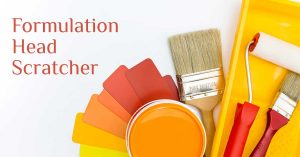
EDITOR'S NOTE: We are introducing a series of posts called "Head Scratchers," featuring real-life coatings formulation challenges and how our coatings expert Philip Green and his team handled them. Welcome to the first installment! We will first present the challenge, with the solution hidden, so you can first consider how you might handle the situation. Then you can click the drop-down to see Philip's resolution. After reading through, we welcome your comments on the resolutions, and any similar challenges you currently have, or how you have handled them in the past.
BACKGROUND
A Southern African coastal-based medium-to-large regional paint company has been making a premium, mostly interior paint for five years with a steady increase in sales. They therefore commission you as an independent consultant to “blind” evaluate samples of their product, plus their main market competitors, considering the issues below.
See my modified version of the formulation, taking all the above points into account.
EXTERIOR ACRYLIC ULTRA MATT INTERIOR PASTEL BASE
PG MODIFIED VERSION
| RAW MATERIAL | KG/APPROX 1000 L | ACTION |
| WATER | 275-0 | PREMIX FOR 5 MINS IN CLEAN POT |
| HEC 4-6000 CPS GRADE | 5-0 | |
| SHMP | 1-2 | ADD SEPERATELY IN ORDER SHOWN - MIX 2 MINS |
| 45% Solids POLYACRYLATE | 4-0 | |
| DEFOAMER | 4-0 | |
| INCAN BIOCIDE | 2-0 | |
| DRY FILM BIOCIDE | 5-0 | |
| TIOXIDE | 175-0 | DISPERSE UNDER HSD FOR 20-25 MINS, UNTIL GRIND IS 50 MICRONS MAX |
| 10 MICRON CACO3 | 100-0 | |
| TALC | 65-0 | |
| ATTAPULGITE CLAY | 3-0 | |
| DIATOMACEOUS EARTH | 35-0 | |
| WATER | 20-0 | WASH SIDES OF VESSAL |
| WATER | 17-0 | LETDOWN, ADD, MIX FOR 10 MINS, COOL TO 40 DEG C MAX |
| COALESCENT | 21-5 | |
| WET EDGE SOLVENT | 21-2 | |
| DEFOAMER | 2-0 | |
| WAX DISPERSION | 5-0 | |
| ADHESION PROMOTED PA | 375-0 |
SIEVE INTO BATCH SLOWLY MIX FOR 10 MIN |
| MICROVOID OPACIFIER | 50-0 | |
| WATER | 49-3 | PREMIX, ADD, MIX FOR 5 MINS, ADJUST PH TO 8.3-8.7 WITH DISACOAT |
| RHEOLOGY MODIFIER | 5-0 | |
| COMBINATION | ||
| WATER | 15-7 | ADJUST VISCOSITY |
| TOTAL | 1259.8 |
QUALITY CONTROL TESTS
|
VISCOSITY |
95-105 KU @ 23 DEG C |
|
SG |
1.21-1.25 |
|
FOG |
30 MICRONS MAX |
|
VOL SOLIDS |
30-32 % |
|
PVC |
38-42 % |
|
pH |
8.3-8.7 |
|
SHORTFALL FACTOR |
0.984 |
|
SHEEN SIMILAR TO STANDARD (LESS THAN 3/85 DEG HEAD MAX) OPACITY SIMILAR TO STANDARD BRUSH, ROLLER APPLICATION, FLOW SIMILAR TO MAJORS |
|
The views, opinions and technical analyses presented here are those of the author or advertiser, and are not necessarily those of ULProspector.com or UL Solutions. The appearance of this content in the UL Prospector Knowledge Center does not constitute an endorsement by UL Solutions or its affiliates.
All content is subject to copyright and may not be reproduced without prior authorization from UL Solutions or the content author.
The content has been made available for informational and educational purposes only. While the editors of this site may verify the accuracy of its content from time to time, we assume no responsibility for errors made by the author, editorial staff or any other contributor.
UL Solutions does not make any representations or warranties with respect to the accuracy, applicability, fitness or completeness of the content. UL Solutions does not warrant the performance, effectiveness or applicability of sites listed or linked to in any content.



Philip Green was my mentor after leaving university and whilst working at Dulux. He is such a wonderful man and passionate about Surface Coatings Technology. In 1998 I moved to New Zealand and so we have lost contact – please can you pass on my contact details or alternatively provide me with his email address. Thank you, kindly, Jacqueline Hickman
– What kind of product is “ADHESION PROMOTED PA” (It is the largest on the formula)
– Why to use wet edge solvent if it is white color ?
– What is ” SHORTFALL FACTOR ”
Thank you
new paint formulation and development of not existing paint
Michael I am not too sure in what Context I should answer your Comment -are you saying the Head Scratcher Does not make sense to you(if so in what sense) or are you wanting Further information on the Topic ?
@phillip Green, can you please include the former formula of the manufacturer so it could be clearer which part that the components were improved.
Thanks
Huong I have sent you all the requested info /formulations to your Gmail address
El disolvente de borde mojado: Es propylen glycol? o un Dowanol? cual?
Propylene Glycol